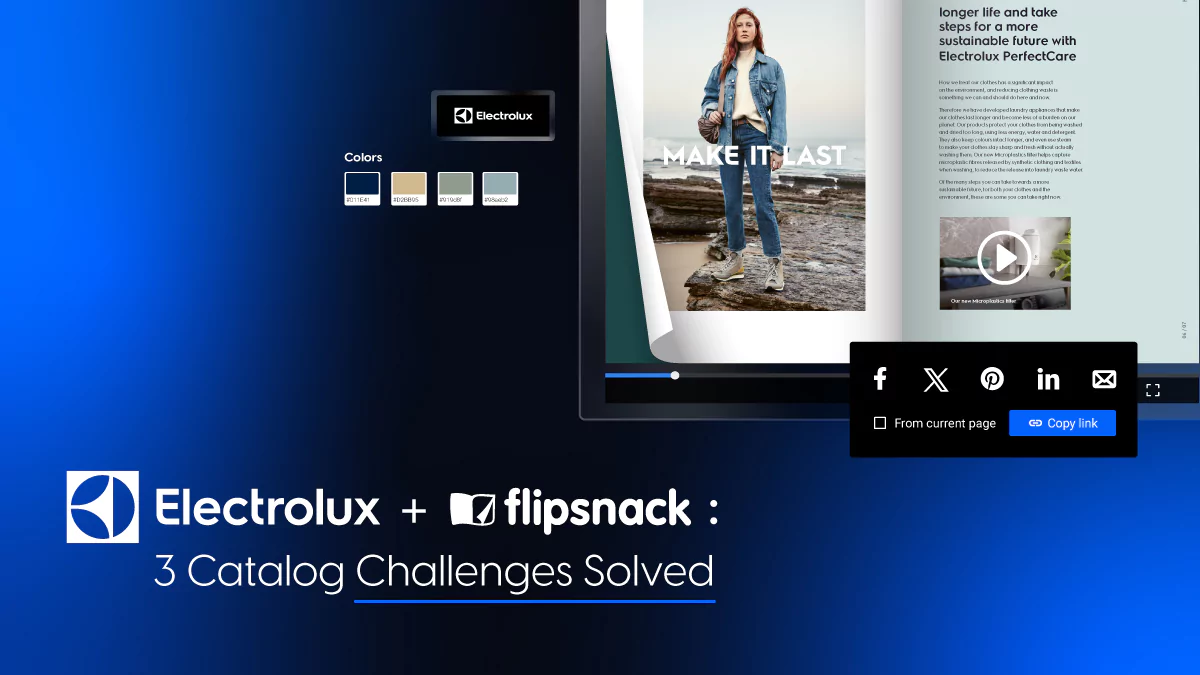Actionable tips for your green marketing strategy
Green marketing has always been an effective way to promote your ideas, but also stay environmentally conscious. As time has gone on, it’s made more and more of an impact. Finally, we’ve reached a point where we can all do our part to really make a difference. It’s a social responsibility.
Everyone is talking about green marketing nowadays, especially as we move closer to an environmentally conscious society. Big celebrities are highly focused on the environment and big brands center their culture around it. Sometimes, these companies dedicate entire CSR campaigns just so they can brag about what they’re doing.
On top of that, there are many articles out there that tell you to use messaging apps and CRMs that are “green”, but they never really elaborate on how it actually helps. Sure, many brands out there have no direct tie to helping the environment donate and plant trees, but their solution isn’t exactly green, it’s just digital.
Entire companies spend millions upon millions of dollars on green marketing campaigns and brag about going green, but what are they actually doing to make a difference? The reality is that companies harm the environment in ways that most people don’t even realize. And the truth is that even with a smaller budget, there are a number of things that we can do to make a difference. But first, let’s talk about a few fundamentals.
What is green marketing?
Green marketing is the practice of advertising and marketing strategy based on sustainability. These are companies that base their culture and campaigns on environmentally friendly products and services. That being said, you could distinguish this idea even further, as there are some differences between green marketing and sustainable marketing.
Some examples of green marketing could be a company that focuses their advertising on the fact that they use biodegradable packaging. Or, a company like Flashfood, which centers its entire culture around saving the environment (and your wallet) by reducing food waste.
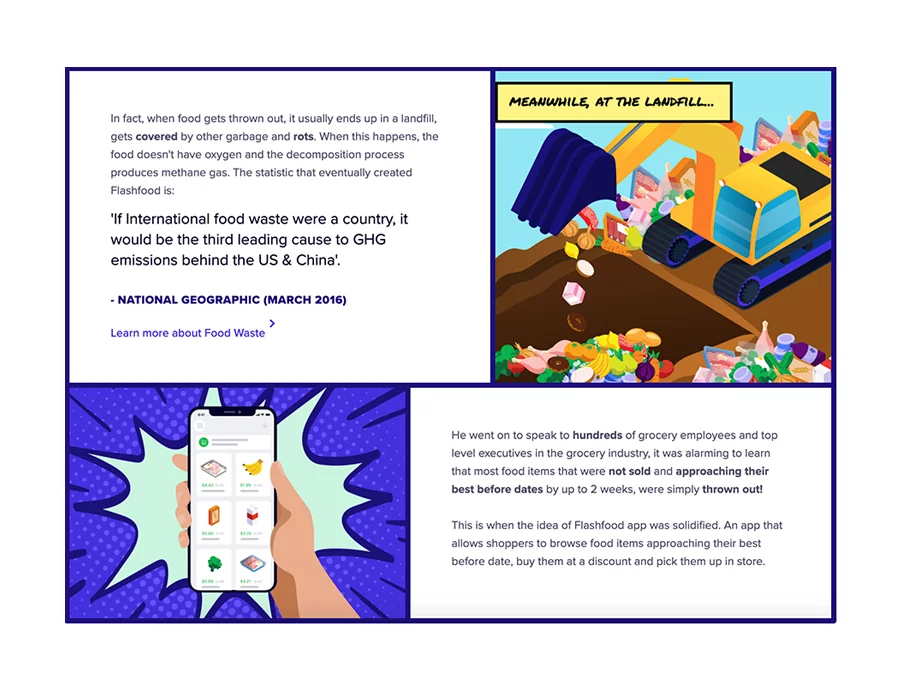
Anything and everything within a company that is considered environmentally friendly can be used for green marketing. If you’re truly about the cause, then the green marketing aspect should come naturally.
Green marketing vs Greenwashing
One thing that some companies have been caught red-handed doing is something called greenwashing. Essentially, this is where a company claims they adopt green practices, but they actually don’t do anything different. They promote an idea, but never really follow their own advice, and absolutely zero environmental benefits come from it.
Around certain times of the year, companies will use a new logo. There’s nothing different about this logo other than it’s green where it was previously another color.

Although the logo above is fictional, this is a very common tactic used by a few big brands to make you more emotionally attached to their idea of green marketing. It’s very smart, but it is pretty transparent if you know what you’re looking for. It’s all psychological, with no sustenance to back it up.
The best advice anyone can give here is to do research on a company before buying in. If someone is passionate about the environment, and they base their purchasing decisions on that, then they will definitely make sure they know what they’re buying. This is exactly why, as a marketer, communications specialist, or even a business owner, you need to show your effort from front to back.
It’s not about changing a logo, it’s about changing the world for the better.
Some brands even use this idea of green marketing to bring in temporary traffic with “tips” that we’re all using anyway and don’t actually solve a problem. In a way, you can think about this as greenwashing, as it doesn’t provide anything of sustainable value. We all know that we need to turn off lights and crack a window instead of turning on the AC. What we’re after in green marketing are ways that your brand can change for the better, inside and out. As companies transition to more sustainable practices, they’re also embracing digital transformations. Consider using a discount promo voucher to enjoy ready-to-eat meals delivered to your door with minimal environmental impact. Using a cloud contact center, for instance, streamlines customer service and reduces the carbon footprint by eliminating the need for physical infrastructure and hardware.
Three points to remember in green marketing
In order to avoid greenwashing yourself (yes, it can happen by accident), there are three points that you should take into consideration.
- Passion
It should come as no surprise that you have to be passionate about something in order to really sell it. Green marketing is no different. You have to be passionate about changing the world one step at a time. Every snowstorm starts as a snowflake, every hurricane is brought forth by a single lightning bolt, and every movement starts with a single action. Be passionate about it.
- Purpose
Passion is the start, but purpose drives your efforts forward. In order to market your sustainability, it has to serve a purpose. We all know about the people and restaurants that banned plastic straws. This was a green marketing effort that had a purpose: to prevent them from going into the ocean and harming marine life. If you don’t yet know the green-focused purpose of what you’re selling, it’s time to re-evaluate.
- Precision
You definitely need to be precise in green marketing. You can’t be jumping all over the place. Find your niche, and run with an idea. Be deliberate with your marketing strategy. For a lot of people, this really does matter tremendously.
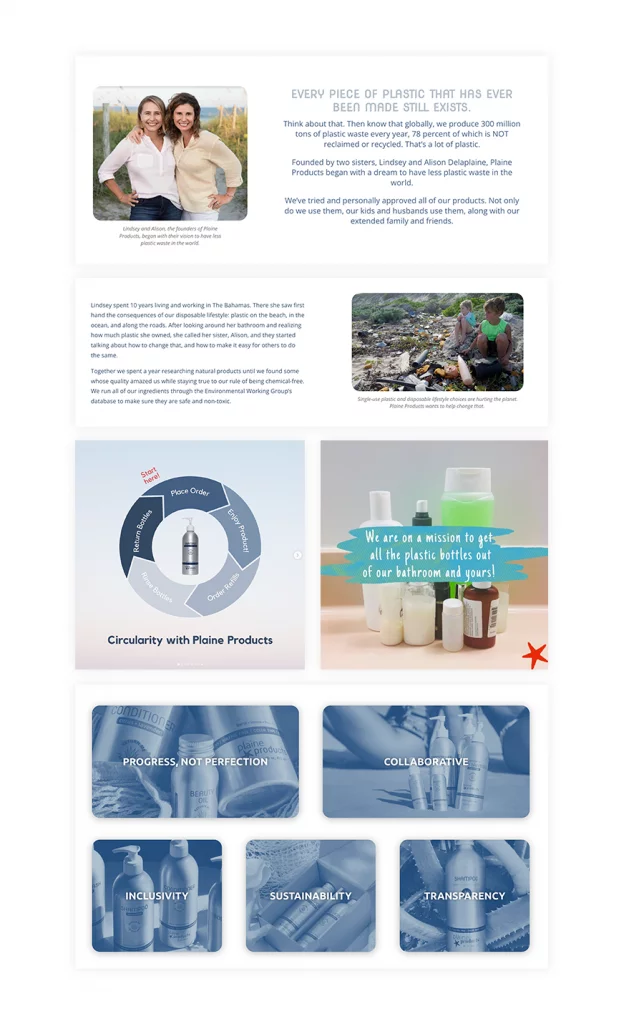
A good example of a company that markets its passion and purpose, and does it with precision is Plaine Products. They are extremely passionate about their environmentally friendly products, and it really shows in everything they do. There are highlighted selling points like zero-waste and refillable packing, vegan and cruelty-free, and a lot more. They are all about the cause, have a green-focused purpose for all their selling points, and market to a very specific target audience with precision.
Green marketing ideas ready to implement for your business
That leads us to the idea portion of this article. Remember, the idea here is to spark inspiration, not to shout out tools that have almost nothing to do with green marketing. We’re after solutions, not cheap content filler.
With that said, here are some ideas that you can use to make a green impact.
- Save paper, go digital
- Follow the five Rs
- Create green selling points
- Go remote
- Optimize your eCommerce shop
- Promote your green efforts through marketing
Save paper, go digital
In this day and age, marketing is done almost primarily online. Even the good old-fashioned retail catalogs are digital now. That being said, there are still some ways paper can leak onto the scene. For example, if you’re a printing company and you publish magazines. Or maybe you’re a travel agency, and you print brochures. Or more generally, for any company, you have internal documents that you print out.
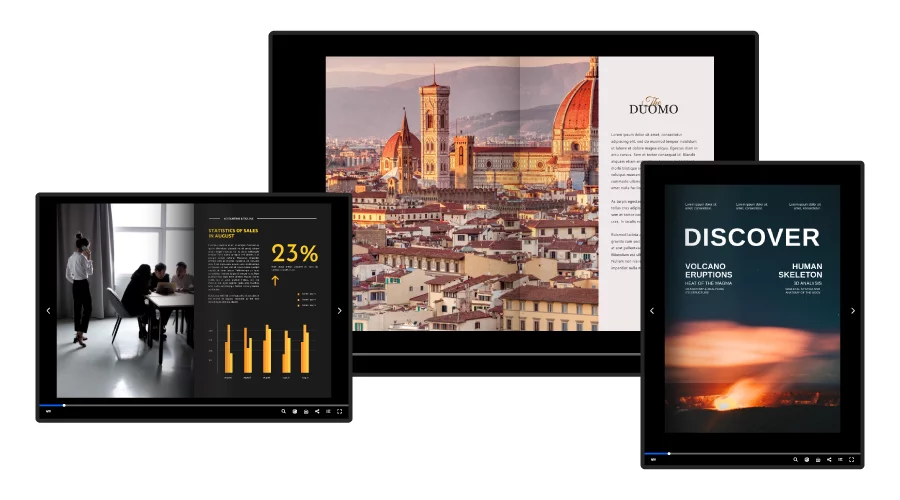
All of these are ways that paper still finds its way into the workplace. In some aspects, paper and printing are unavoidable, but on a large scale, most things can now be done and stored securely online. This eliminates the need for paper in your marketing strategy and internal communication almost entirely.
Since COVID-19, this trend has really accelerated. It pushed companies that were 100% in office to be at least partially digital because of remote-working employees. For many, swapping to digital solutions really changed the way they operate.
Follow the five Rs
A recurring theme throughout your journey with green marketing is going to be practicing what you preach. It is absolutely vital that you try, in every way, to be green. If it truly is a passion of yours, then you could even incorporate sustainability into your company culture.
One of the best ways to accomplish this is to follow the five Rs. Those five Rs are refuse, reduce, reuse, repurpose, and recycle. Typically, this is something that we’re taught for everyday use, in our own homes, on our own time. But who says that it can’t apply to business?
These five Rs are meant to be taken in steps. Starting from the top, let’s go into a little more detail.
What are the five Rs?
Refuse – This point is pretty simple. Refuse to waste. Look for any and every way that you can reduce the amount of generated waste around the office. Instead of using disposable cups for coffee, have employees bring their own, or provide some. Instead of printing a bunch of fliers for a company retreat, make digital brochures and share them via email.
Reduce – In the ways that you can’t refuse, look for ways that you can reduce the waste. Maybe you can’t eliminate paper cups, but you can eliminate plastic lips. It’s all about finding ways to reduce your carbon footprint.
Reuse – In many offices, you’ll probably find single-use plastics. These are designed to be used only once and then sent off to a landfill. Definitely not ideal for green marketing. Instead, use dishes that can be cleaned, provide water bottles to the team, and anything else you can think of to reduce waste.
Repurpose – Repurposing has actually become a huge green trend. People are taking wooden pallets and making furniture and plastic bottles and making flower vases. In an office setting, you can try buying furniture that’s made out of recycled materials.
Recycle – Finally, after you’ve tried everything else, then it’s a good idea to recycle. Many countries make it a priority to recycle as much as they can, but businesses are often the biggest contributor to waste simply because they have so many employees. Start a recycling program in your office, gathering metals, glass, plastics, and paper, and making it a priority to get them recycled.

Create green selling points
As I said just above, you really want to avoid greenwashing at all costs. It’s not a good look and can bring a lot of unnecessary judgment on your brand. To combat this, and to really be about the cause, you should come up with some eco-friendly selling points. Remember, green marketing is about purpose!
These selling points most definitely should not be forced. They should be real, tangible points that can be proved and easily recognizable. For example, maybe your company sells an environmentally friendly product that is very energy efficient. Or perhaps, it’s made using very little energy and resources. These are big selling points and most definitely contribute to a successful green marketing campaign.
Remember, you only want to use the ones that actually make sense for your brand. If you promote something green about your company that’s not actually true, people will find out. No greenwashing! Make it real and genuine, and people will appreciate you even more.
- Non-toxic ingredients
- Sustainably produced
- Ethically sourced
- Zero chemicals
- Made from recycled materials
The list can go on and on, but the overall idea is that everything “Green” about what you’re selling could be a massive selling point. Doing this research might even help you uncover ways that you can change your product or service to become greener.
A good example of this is a company called Green Toys. They make their eco-friendly kids’ toys out of recycled, sustainable materials, and they heavily implement green marketing. Right from their main page, you can see all the big selling points. Of course, they mention the recycled materials they use to create the toys, but they also ship using 100% recyclable materials. Any parent looking for an eco-friendly toy for their child will be able to find these guys right away.
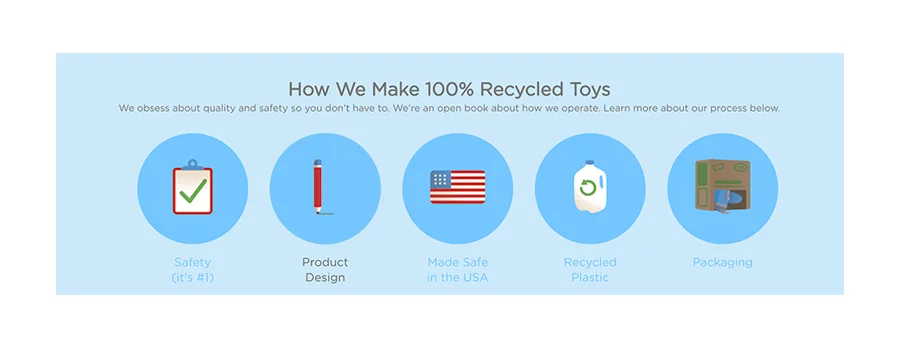
Go remote
Being a little more remote is something that we all learned to do recently. For some people, working from home or at least not at the office was probably hard to adapt to, but it promotes so many green benefits.
For starters, you’re not driving back and forth to work, saving gas, and not putting emissions into the air. Fewer people at the office means fewer resources being used. Less water and electricity. This will reduce your carbon footprint drastically. Furthermore, you can use an employee cost calculator to quantify the cost savings associated with remote work accurately, perhaps even donating the balance to ecological charities.
Many might not view this as a marketing tactic, but it’s simply not true. Anything you do within your company can be used to promote your efforts. This goes back to using green marketing for a purpose. If you truly are working remotely in order to reduce your carbon footprint, it’s something worth bragging about a little bit.
Optimize your eCommerce shop
For most brick-and-mortar businesses, it can be both costly and inefficient. At least, it’s not as cost-effective and sustainable as it could be. But, the same can be said about shopping online
For smaller stores, selling online reduces your carbon footprint in many ways. Shipping is more efficient than having hundreds or even thousands of people driving to your stores. Instead of having to open up another location every time you meet your growth goals, you can simply invest in advertising and meet the needs of your target audience through digital media.
But what about bigger stores? For an online retailer, like Amazon, the biggest impact will come from packaging, freight, and delivery. Optimizing these aspects and swapping to more eco-friendly packaging can lead to some surprising results.
To further enhance sustainability in the realm of eCommerce, larger retailers like Amazon can explore innovative strategies such as leveraging sustainable data centersfor their data center infrastructure. These eco-friendly data centers not only reduce energy consumption but also align with the broader goal of minimizing the environmental impact of their operations, ultimately contributing to a greener and more efficient online shopping experience.
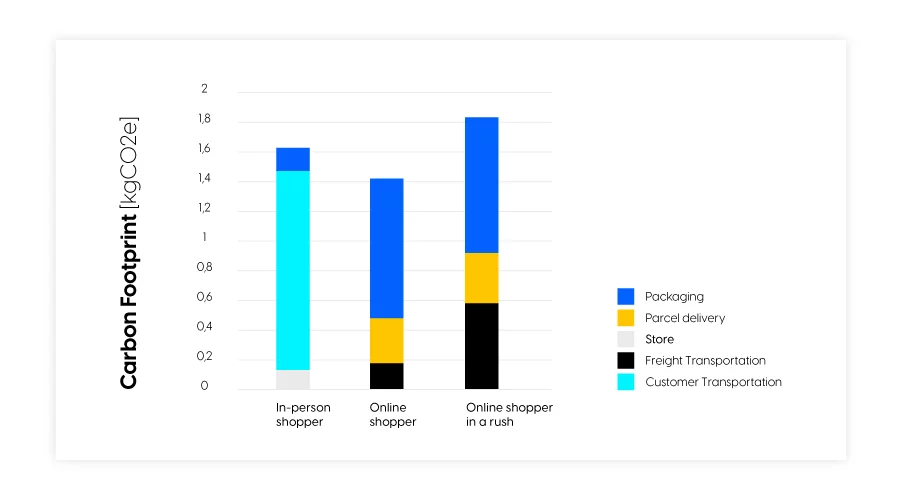
As you can see from this breakdown, this is where the biggest environmental impacts are made. From a business standpoint, you can see where the biggest room for improvement is in each category. For in-person shoppers, the biggest impact comes from customer transport. Businesses can’t do much about that. But for online shopping, whether the customer is in a rush or not, there are some areas where businesses can make a difference.
In fact, larger eCommerce retailers like Walmart and Amazon produce 17% less emissions than smaller, brick-and-mortar stores. This is thanks to increased efficiency on a global scale.
In all honesty, the age of brick and mortar stores is coming to an end. Sure, they will always exist, but the internet has made way for more logical, purposeful, and effective marketing and selling. It may be costly at first, but you should definitely try focusing some more effort on selling online.
Promote your green efforts through marketing
Finally, after all of this is put into place, you have to lead by example. Use your green efforts by creating content around it, chipping in locally with environmental work, and showcase the steps that your business is taking to reduce waste.
Doing all of this will hopefully encourage participation, giving others the initiative they need to really make a difference themselves.
That’s why, at Flipsnack, we strive to give others the power to reduce their own carbon footprint. Whether you’re in an office, or working remotely, using a paperless publication tool allows you to do everything you need to do in order to create engaging brochures, fliers, magazines, newsletters, and more, all without having to print.
We’re on a mission to help businesses around the world, big and small, to reduce their own carbon footprint. With Flipsnack, you can take your PDFs and transform them into brochures, magazines, catalogs, and more. Once that’s done, we give you all the tools you need to share your marketing materials securely and quickly. No matter who you are, whether you’re tech-savvy or not, this is an easy solution that can greatly reduce the impact you have on the environment.
Green marketing is the new black
Although it can be tough to think of ways to be sustainable in the office, it’s not all impossible. In reality, anything and everything that you do that’s considered “green” in the workplace can be used for marketing, PR, and making the world a better place.
Nobody is expecting you to go fully green overnight, but there are some environmental issues that you can address in the long run. For companies and brands that are set in their ways, this could be a massive transition that could take weeks, months, or even years. What’s important now is that you start to look for solutions.
Save paper with tools that allow you to create marketing materials and communicate internally while being fully digital. Give employees the option and resources they need to work from home, reducing airborne emissions. It can even be as simple as reducing the amount of waste you produce, reusing any and all materials that you can, and recycling what’s left. In conclusion, we all have a part to play in making the world a better place. Even in the workplace.


